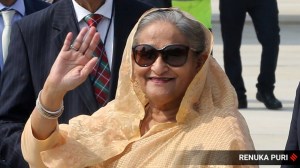After tax relief in Budget, RBI cuts key rate, first in five years, to spur growth
RBI keeps stance neutral, expects growth to be 6.7% in FY26, estimates inflation at 4.2%
 RBI Governor Sanjay Malhotra along with Deputy Governors M Rajeshwar Rao, Swaminathan Janakiraman and T Rabi Sankar in Mumbai on Friday. (Image: Amit Chakravarty)
RBI Governor Sanjay Malhotra along with Deputy Governors M Rajeshwar Rao, Swaminathan Janakiraman and T Rabi Sankar in Mumbai on Friday. (Image: Amit Chakravarty)AS WIDELY expected, the Reserve Bank of India’s (RBI) Monetary Policy Committee (MPC) unanimously decided to reduce the repo rate — the interest rate at which it lends to banks — by 25 basis points (bps) to 6.25 per cent amid easing inflation and worries over slowing growth due to global uncertainties.
The six-member rate-setting panel has projected the real gross domestic product (GDP) at 6.7 per cent and the retail inflation at 4.2 per cent for the fiscal 2025-26.
The cut in the key policy rate — the first in nearly five years — will provide relief to home, vehicle, and other consumer loan borrowers as all interest rates linked to the repo rate will come down by 25 basis points (bps) immediately. One basis point (bps) is one-hundredth of a percentage point.
“The MPC noted that inflation has declined. Supported by a favourable outlook on food and continuing transmission of past monetary policy actions, it is expected to further moderate in 2025-26, gradually aligning with the target,” RBI Governor Sanjay Malhotra said.
“The MPC also noted that though growth is expected to recover from the low of Q2 of 2024-25, it is much below that of last year. These growth-inflation dynamics open up policy space for the MPC to support growth, while remaining focussed on aligning inflation with the target. Accordingly, the MPC decided to reduce the policy repo rate by 25 basis points to 6.25 per cent,” he said, announcing his first monetary policy after taking over the charge as Governor in December last year.
As per the first advance estimates by the National Statistics Office (NSO) in January, real GDP growth for the current year is estimated at 6.4 per cent, a softer expansion after a robust 8.2 per cent growth last year. Under the flexible inflation targeting (FIT) regime, the government has mandated the RBI to keep consumer price index (CPI) inflation in the 2-6 per cent band. It has been targeting to keep CPI at 4 per cent on a durable basis.
In December, retail inflation eased to a four-month low of 5.22 per cent from 5.48 per cent in the previous month.
The MPC, however, decided to continue with a neutral stance which will provide it the flexibility to respond to the evolving macroeconomic environment.
“Considering the existing growth-inflation dynamics, the MPC, while continuing with the neutral stance, felt that a less restrictive monetary policy is more appropriate at the current juncture,” Malhotra said. The MPC, he said, will take a decision in each of its future meetings based on a fresh assessment of the macroeconomic outlook.
On growth, the Governor said the economic activity is expected to improve in the coming year.
Rural demand continues to be on an uptrend, while urban consumption remains subdued with high frequency indicators providing mixed signals. Going forward, improving employment conditions, tax relief in the Union Budget, and moderating inflation, together with healthy agricultural activity bode well for household consumption. Government consumption expenditure is expected to remain modest.
The MPC has projected the real GDP growth for FY2025-26 at 6.7 per cent, with Q1 at 6.7 per cent; Q2 at 7 per cent; Q3 at 6.5 per cent; and Q4 at 6.5 per cent.
“Global headwinds, however, continue to impart uncertainty to the outlook and pose downward risks,” he said.
The inflation estimate for FY2024-25 has been kept unchanged at 4.8 per cent.
Assuming a normal monsoon next year, CPI inflation for 2025-26 is projected at 4.2 per cent, with Q1 at 4.5 per cent; Q2 at 4 per cent; Q3 at 3.8 per cent; and Q4 at 4.2 per cent, the RBI Governor said.
To a question on whether the current depreciation in the rupee has been factored into RBI’s inflation forecasts, Malhotra said, “Yes, the latest rupee to dollar rate was taken into account while making all our projections.”
When asked about the RBI’s concerns over the declining rupee and worries over imported inflation, the RBI Governor said a lower rupee certainly puts pressure on inflation but the higher worry is global uncertainties. “Global uncertainties, even if tariff trade wars are not to be carried out, itself is something which is worrisome. This has a direct impact on growth, investment decisions and consumption expenditure decisions which get deferred,” he said.
“So, this uncertainty being the underlying cause to a great extent of the dollar strengthening and rupee depreciation is not good for growth and imported inflation. This is something which we need to be cognisant about,” Malhotra said.
On the regulatory front, the Governor said the RBI would continue to strengthen, rationalise and refine the prudential and conduct-related regulatory framework in the overall interest of the economy.
On the proposed liquidity coverage ratio (LCR) framework, the governor said that implementation of the norms has been deferred by a year.
“Less than two months is too short a window for banks, we realised that and so we will give at least March 31, 2026. It doesn’t mean it has to be March 31, 2026. We will aspire for that but we want to make it very smooth and it will also be phased.”
The RBI released a draft LCR guidelines in July 2024, which were to be implemented by April 1, 2025. Under the norms, it was suggested that banks would assign an additional 5 per cent ‘run-off factor’ for retail deposits which are enabled with internet and mobile banking facilities. The RBI has received comments from various stakeholders on LCR norms and it was examining those but the examination will take some more time, he said.



- 01
- 02
- 03
- 04
- 05




























